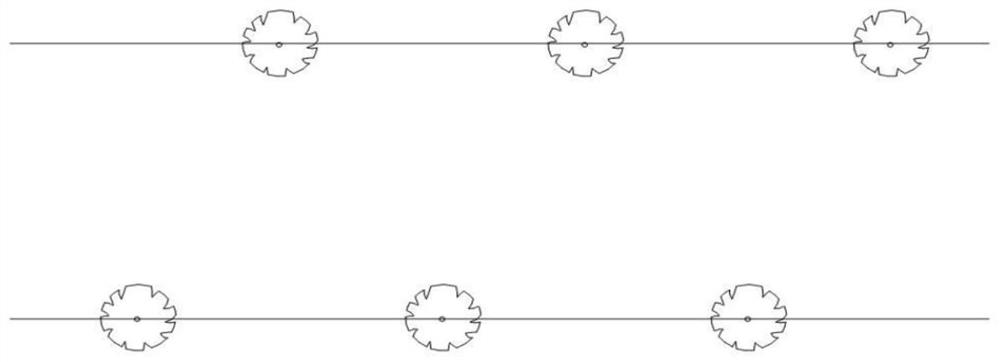Method for establishing cotton field protection forest in newly-cultivated saline-alkali land
A technology of saline-alkali soil and shelterbelt, which is applied in botany equipment and methods, cotton cultivation, plant protection, etc., can solve the problems of biological nitrogen fixation and saline-alkali soil improvement, unrealizable economic benefits, and low saline-alkali tolerance. Achieve the effects of improving saline-alkali soil, improving soil fertility, and increasing productivity
- Summary
- Abstract
- Description
- Claims
- Application Information
AI Technical Summary
Problems solved by technology
Method used
Image
Examples
Embodiment 1
[0027] (1) Deep plow the saline-alkali soil, dry it until it can be mechanically rolled, divide it into 100m long and 20m wide fields, excavate 80m wide water canals around the fields, and use them as canal ridges to synchronize with cotton field sowing. The row spacing of cotton in the described cotton field is 60cm, and the plant spacing of cotton is 8cm, and the sowing depth of cotton is 3cm, selects the biennial cuttage seedlings of the strong uprightness of the canopy, and in spring, along the ditches on both sides of the canal, according to the 3m The distance between the plants is carried out to plant 2 rows of saplings of Jujube saplings in a character shape;
[0028] (2) Irrigate cotton fields;
[0029] (3) After the cutting seedlings survived, wipe the buds and trim the side branches in time, so as to promote the high growth of the big scorpion, cultivate the main trunk, and control the height of the branches to 1.5m.
[0030] During this period, there is no need to...
Embodiment 2
[0032] (1) Deep plow the saline-alkali land soil, dry it until it can be mechanically rolled, divide it into 100m long and 20m wide field pieces, excavate 80cm wide water channels around the field pieces, make canal ridges, and synchronize with cotton field sowing. The row spacing of cotton in the field is 70cm, the plant spacing of cotton is 10cm, and the sowing depth of cotton is 4cm. Select the biennial cutting seedlings of the big upright tree canopy. Carry out the character type planting 2 rows of big sandy jujube trees;
[0033] (2) Irrigate cotton fields;
[0034] (3) After the cutting seedlings survive, timely take measures to smear buds and trim side branches, cultivate the main trunk, and control the height of the branches to 1.5m.
[0035] During this period, there is no need to take any management measures such as fertilization and weeding. After 3 years of planting, a small amount of fruiting began to appear. At the same time, the benefits of ecological protectio...
Embodiment 3
[0037] (1) Excavate the saline-alkali land and dry it until it can be mechanically rolled. After rolling and leveling, excavate the blind ditch for salt drainage, backfill the medical stone and the blind pipe, and after the pretreatment is completed, it will be synchronized with the sowing of the cotton field. The row spacing of cotton is 60cm, the plant spacing of cotton is 8cm, and the sowing depth of cotton is 3cm. Plant 2 rows of large jujube trees with a plant spacing of 3m;
[0038] (2) Irrigate cotton fields;
[0039] (3) After the cutting seedlings survive, timely take measures to smear buds and trim side branches, cultivate the main trunk, and control the height of the branches to 1.6m.
[0040] During this period, no management measures such as fertilization and weeding were required. After 3 years of planting, a small amount of fruiting began to appear. At the same time, the benefits of ecological protection also appeared in time. It entered the early stage of fruiti...
PUM
 Login to View More
Login to View More Abstract
Description
Claims
Application Information
 Login to View More
Login to View More - R&D
- Intellectual Property
- Life Sciences
- Materials
- Tech Scout
- Unparalleled Data Quality
- Higher Quality Content
- 60% Fewer Hallucinations
Browse by: Latest US Patents, China's latest patents, Technical Efficacy Thesaurus, Application Domain, Technology Topic, Popular Technical Reports.
© 2025 PatSnap. All rights reserved.Legal|Privacy policy|Modern Slavery Act Transparency Statement|Sitemap|About US| Contact US: help@patsnap.com



